
Glénat, 2019
Visit my virtual exposition, with sketches and a close view on some original drawings.
‘Minnie Mouse et le Secret de Tante Miranda’ is the second Disney album made by Cosey after ‘Une mystérieuse mélodie’ (2016). Cosey has often told that making a Mickey (or Minnie) album is a childhood dream come true: as a child he was an avid reader of Mickey magazine.
Soon after ‘Une mystérieuse mélodie’ appeared, Cosey told interviewers about ideas for a second Disney story. At the time it was still unknown if authors were allowed to make a second album – well, it happened. In interviews (see my blog post), Cosey tells that, for inspiration, he went back to the first appearances of Mickey and Minnie. Minnie was already present in the earliest stories as Mickey’s girl friend: how did they meet? This led to Cosey’s first Disney-story. Also, Cosey discovered that Minnie had never been the main character of a story: a challenge he took up writing ‘Le Secret de Tante Miranda’!
As you might know, in ‘The World of Cosey’, I don’t want to give summaries of albums, and no reviews. I like to dive into backgrounds of the stories. In this article, I will go into a few ‘echoes’ that resounded in my head up while reading ‘Minnie Mouse et le Secret de Tante Miranda’. These echoes are references to other works By Cosey or to other comics or works of art. Some were made intentionally by Cosey, some are just my brains playing tricks on me – I think all of them increase the pleasure of reading. Enjoy!
Echoes for Cosey-fans
The Minnie album has many references to older Cosey albums. Some are obvious, some are more hidden… and I have surely missed some of them.
One of the most obscure echoes can be read on the envelope of Tante Miranda’s letter to Minnie. Among the wrong names, we read ‘Mimsy’. Jonathan connaisseurs will know that the actress Mimsy Farmer was the model for Kate – a legendary personage from the Jonathan albums.
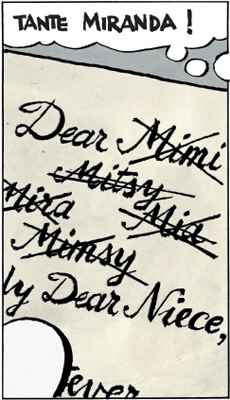
The envelope received by Minnie.
Minnie goes to Yellow Rock on a motorcycle with sidecar. I am convinced she borrowed it from Colonel Lan (Jonathan ‘Celui qui mène les fleuves à la mer’).

The same motorcycle twice.
On page 26, we see Minnie yelling a heartfelt cry: ‘La montagne est à tout le monde!’ (‘The mountains belong to everyone’). I had to think of another heartfelt cry in Cosey’s work. In ‘À la recherche de Peter Pan’, Melvin Woodworth shouts out an ‘I love you’ to the mountains, hoping it will be heard by an unknown woman, whom he has seen bathing in a thermal spring. Minnie definitely knows to whom she is shouting, and it is not precisely a call of love when she continues: ‘Gros Lard!’ (Fat lard!).

Two echoes with quite different content.
In ‘À la recherche de Peter Pan’ we see a dramatic avalanche scene: a scene of destruction and demolition. In the Minnie album, we also see an avalanche. For a few moments, Minnie is struck by a fear that her friend Clarabelle has had a serious accident.
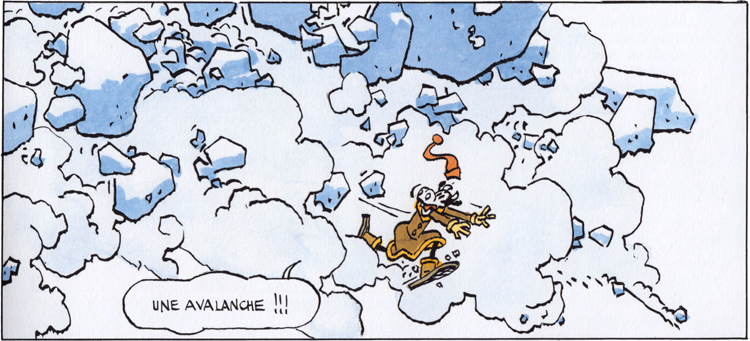
Clarabelle running for her life.
At a certain point in the story, Minnie falls into a ravine (more about that later). At the bottom of the ravine, Minnie hears someone breathing and she doesn’t dare to speak or move and remains silent the whole night. Jonathan readers will remember the impressive night scene when Jonathan encounters Dzaza Dzongzong (in ‘Pieds nus sous les rhododendrons’).
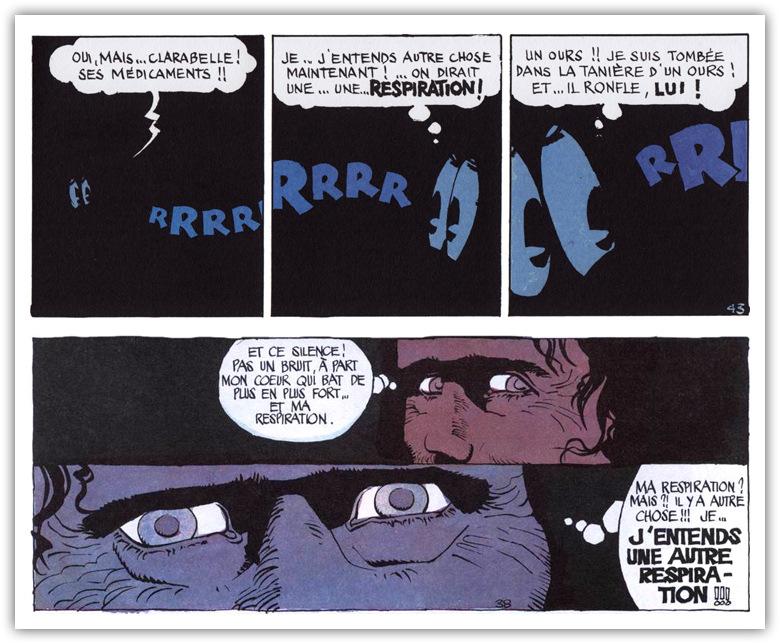
Minnie and Jonathan hear someone breathing.
On page 58, I love the image that is an obvious nod to ‘À la recherche de Peter Pan’. This is clearly not a hidden message!
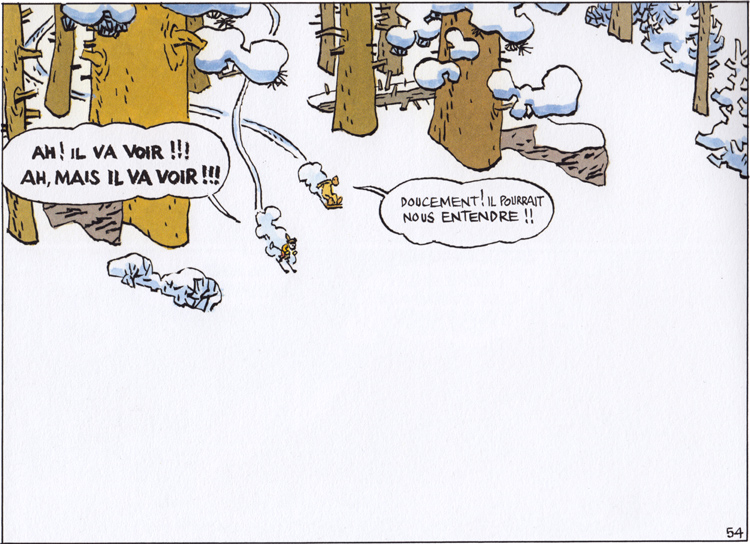
No doubt about this reference to ‘À la recherche de Peter Pan’.
The Minnie-album ends with an epilogue that echoes the epilogue of ‘À la recherche de Peter Pan’, in subject as well as its warm colours. Melvin Woodworth and Evolena visit Italy on a romantic journey, Mickey and Minnie look just as much in love on their way to San Soledad (however, Mickey and Minnie remain strictly chaste).
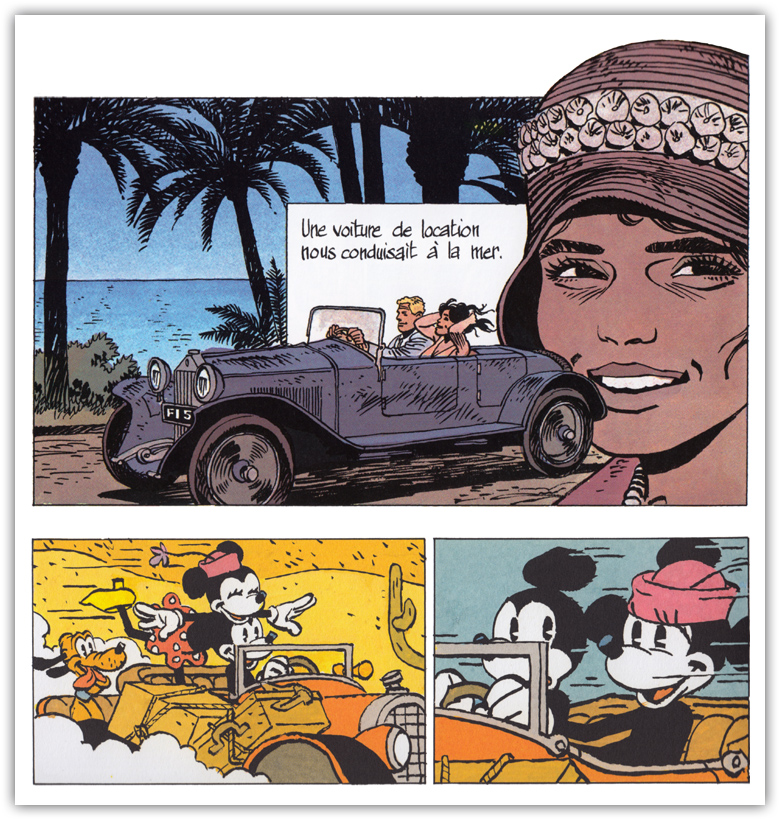
Two happy couples on the road.
Echoes from ‘Tintin in Tibet’
Minnie encounters Bigfoot somewhere near Yellow Rock. Who says Bigfoot, says Yeti, says ‘Tintin in Tibet’ – probably the most famous comic book about the ‘abominable homme des neiges’… I found some similarities between the albums…
In Tante Miranda’s cabin, Minnie and Clarabelle see a picture of the Yeti, taken by Tante Miranda in Tibet. In pose and attitude, the Yeti on the picture reminds us of the first appearance of the Yeti in ‘Tintin in Tibet’.
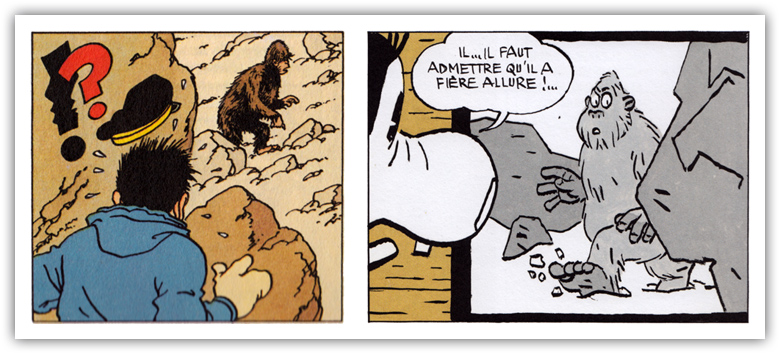
Two Yetis.
There are not so many comic authors who have drawn famous traces in the snow. Hergé and Cosey are two of them. The Yeti traces shown in ‘Tintin in Tibet’ are very similar to the traces of Bigfoot in the american snow.
Hergé’s Yeti and Cosey’s Bigfoot share a healthy appetite. But where Bigfoot prefers cake, the Yeti has a liking for… whisky. Hergé in 1959 certainly did have more liberties to write and draw about drinking (and smoking) than comic authors in 2019, especially when they work on Disney stories – I read in an interview that Cosey had to change coffee into tea.
Hergé’s Yeti and Cosey’s Bigfoot share another characteristic: they save people. Where the Yeti saves Tchang after a plane crash, Bigfoot saves Clarabelle from an avalanche.
The most striking similarity between the two albums is the dramatic scene when Minnie gets lost in a snowstorm at night. She hears a sound, she follows it (a trademark Cosey theme) and falls into a ravine. In ‘Tintin au Tibet’, Tintin gets lost in a snowstorm at night, sees a figure passing that he tries to follow and falls into a ravine. Compare the images!
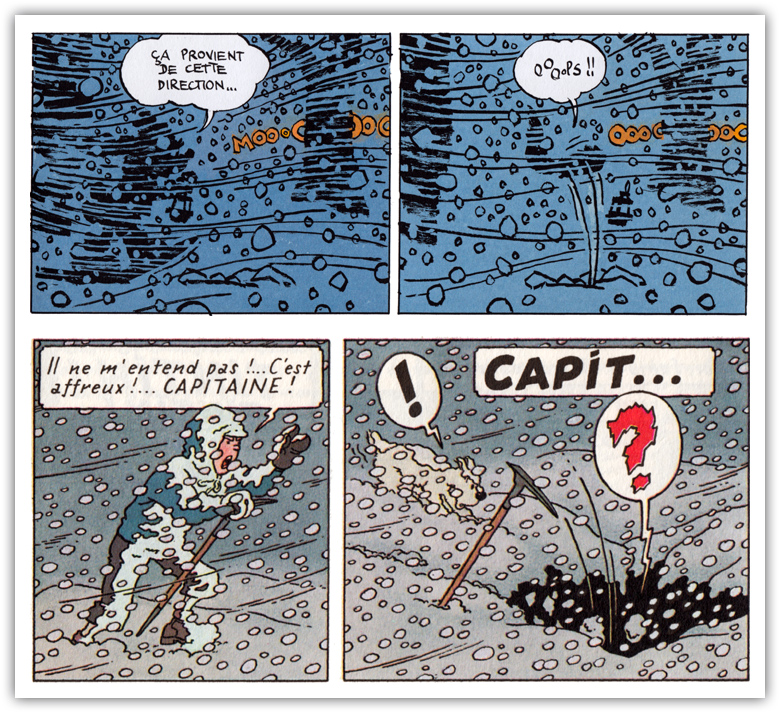
Minnie and Tintin fall into a hole.
Cosey: ‘I swear I didn’t look at ‘Tintin au Tibet’ when I drew this scene, it must be an unconscious memory that came to surface.’
Other echoes
In interviews, Cosey says that he enjoyed working on Minnie. We all know Minnie as pretty modest and timid, but Cosey also shows her fierce side and her fiery temperament. One particular scene stands out: Clarabella and Minnie are locked into a small room by Pat Hibulaire. In a outburst of aggression, Minnie attacks the door with an ax… a scene that reminds me of the frightful Jack Nicholson in ‘The Shining’. It would have been nice if Nicholsons ‘Here’s Johnny’ was echoed by a ‘Here’s Minnie’!

Don’t try this at home.
Minnie has to refuel her motorcycle. It is impossible not to think of Edward Hopper’s famous painting ‘Gas Station’. Cosey confirms!
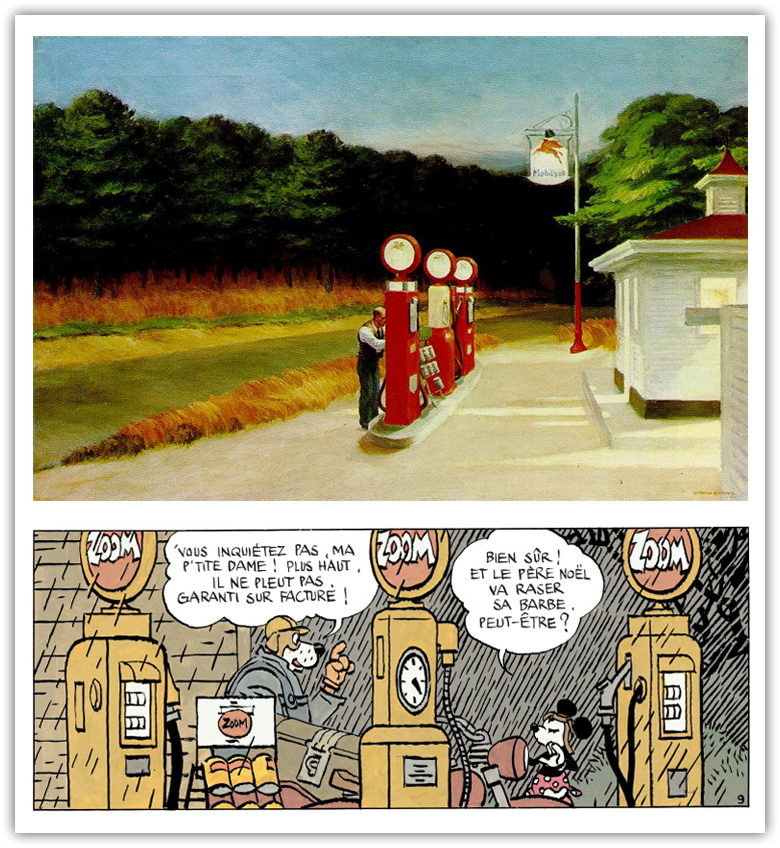
‘Gas’ by Edward Hopper, 1940; gas station by Cosey.
The page opposite to the one with the gas station shows a landscape that reminded me of the landscapes painted by the american painter Grant Wood. Cosey told me he didn’t think of Grant Wood when he drew this, but that he took inspiration by landscapes drawn by Disney artists. Maybe Disney artists were insipred by Wood?
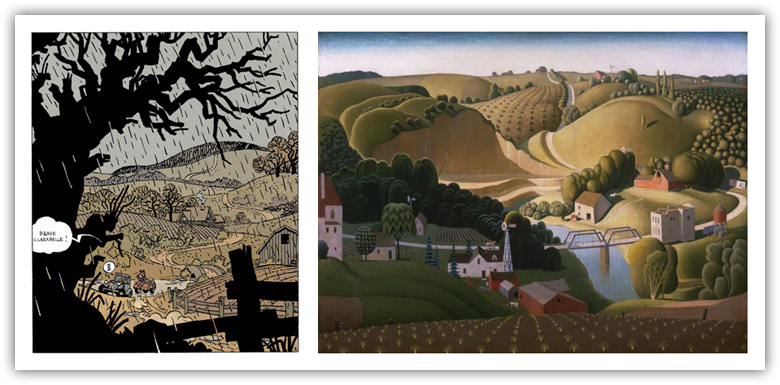
Landscape by Cosey and ‘Stone City, Iowa’ by Grant Wood, painted in 1930.
Cosey is clearly surprised by the resemblance between the landscapes: ‘I didn’t know this landscape by Grant Wood… the resemblance is incredible. Without a doubt, Disney artists must have been inspired by his works.’ … or the other way around. Wood developed his typical painting style with rolling hills, country roads and tiny villages at the end of the 1920s – at the same time, Walt Disney made his first moving pictures.
When Minnie has to spend a night outside, she sings a song to scare away wild animals: ‘Vive le vent, vive le vent d’hiver’. I didn’t know this, but this song is the french version of ‘Jingle Bells’. If you want to hear the song, go to this website.
Well, for this one… you will say that I am taking my investigations much too far. At the end of the album, Minnie shows her thesis about Bigfoot to Tante Miranda. The Thesis Director is ‘Juliet. C. Lucy’ (I pass on the too easy University of Burbank). I wanted to find out who this ‘Juliet. C. Lucy’ is… and I found a ‘Juliette chante Lucy’ on a website called ‘Chroniques du Yéti‘. Is Cosey trying to drive me crazy?
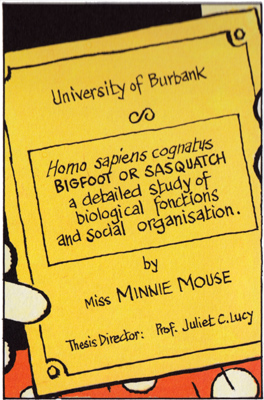
Minnie’s thesis.
A last echo refers to Cosey himself, I think. It is the closing statement of Baby Bigfoot: ‘Pour vivre cachés, vivons heureux’ (‘To live hidden, live happily’) – a wonky translation from the Bigfoot language by Minnie, but we know what is meant. I am convinced this also applies to the discrete Cosey, happy (I hope) and hidden somewhere on his Swiss mountain top.
Bernard Gosselin sent me some interesting remarks on the Minnie album. Here are some of them.
First, he remarks that the colour schemes of the two Disney albums are complementary: warm reds and greens in Mickey, cool blues and oranges in Minnie. Personally, I think the colour schemes are a consequence of the environments in which the stories play; but the differences are clear.
Gosselin also points at the great sense of composition of Cosey: especially by the use of dark trees and roots in the foreground of his images, that serve to ‘frame’ a scene. I totally agree!
He also discovered a reference to a classic comic album. When Minnie and Clarabelle arrive in Yellow Rock, they stay in the ‘Dick Digger’s Mine Inn’. The title of the first Lucky Luke album, published 70 years ago in 1949, is; ‘La Mine d’Or de Dick Digger’.
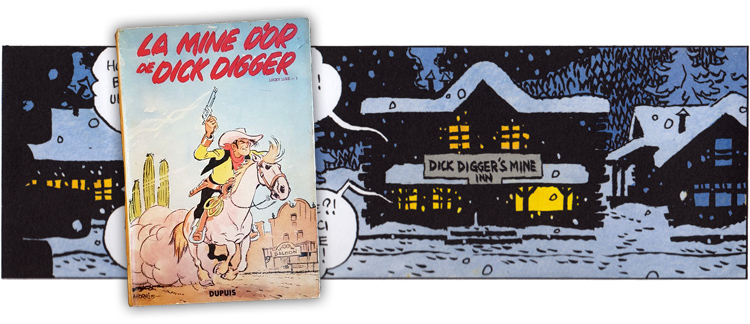
Cover of the first edition of ‘La Mine d’Or’ of 1949; the inn of the Minnie album.
Thank you, Bernard!
In June 2021, Bernard Gosselin sent me another ‘discovery’ regarding the Minnie album. You probably know that Cosey started his career as a comic artist as the assistant of Derib (Claude de Ribeaupierre), creator of, among others, Buddy Longway and Yakari. You also might know that the character Curly in the Buddy Longway series has got the looks of Cosey. Curly appears in several Buddy Longway albums, one of them is ‘La Vengeance’.

In this album, Curly is managers of the ‘Nugget’s Hotel’. Above, you see the hotel as depicted in the album. Bottom right, you see Curly on an image taken from the album ‘La Balle Perdue’.
On page 18 of the Minnie album, Minnie and Clarabelle pass the ‘Gold Nugget Bar’. We only see the door and a window, so we cannot compare it to Derib’s drawing.
Thanks again, Bernard!
November 2019
Roger Klaassen
Originally, the article was published on 20 november.
Remarks by Cosey (on the ‘Tintin au Tibet’ stowstorm scene and the Grant Wood painting) were added 22 november.
Interesting additions by readers will be added when they come…
Images: ©Cosey/Glénat/Le Lombard/Dupuis, 2019
Images from ‘Tintin au Tibet’: ©Hergé/Moulinsart, 2019
Images from Buddy Longway: ©Derib/Le Lombard, 2021

